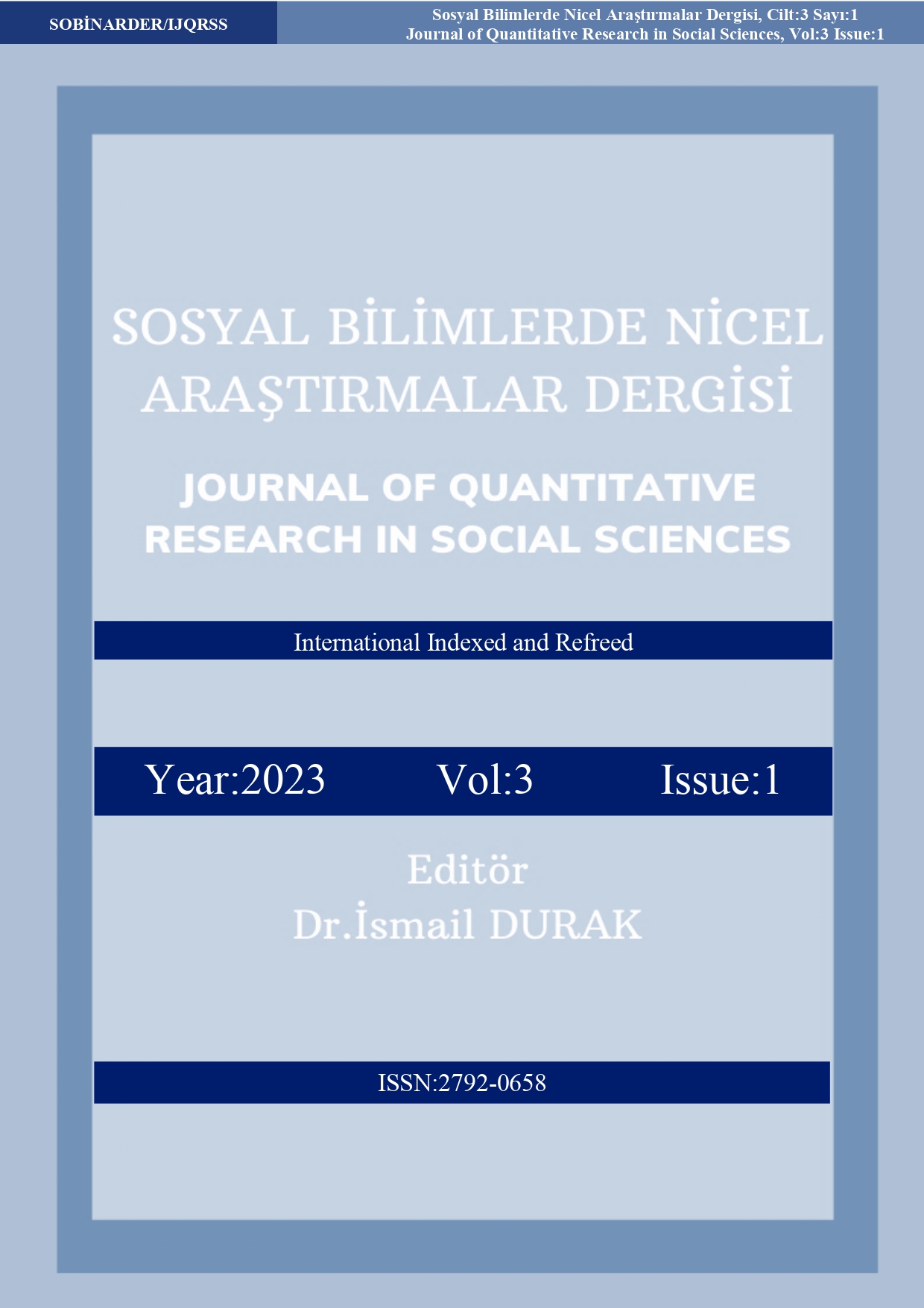Psychometric Characteristics of the Persian Adaptation of the Brand Trust Scale
Keywords:
Brand Trust, Brand Trust Scale, Reliability, ValidityAbstract
This research was carried out to adapt the Brand Trust Scale, originally developed by Delgado-Ballester (2004), into Persian and to examine its psychometric properties. First, the English form of the scale was translated into Persian by the researchers. Then, the opinions of three academicians who are experts in the field of marketing and who are fluent in Persian were consulted on the translation. The Persian form of the scale was created by taking into account the expert's suggestions. Pearson correlation coefficient was used to examine whether the scale had language equivalence. Exploratory and confirmatory factor analysis was used for the construct validity analyzes of the Persian scale, and the AVE and CR coefficients were taken into account. The reliability of the scale was examined on the basis of internal consistency and stability. The Cronbach α coefficient was calculated for the internal consistency analysis of the scale, and the test-retest method was used to determine the stability of the scale. According to the findings of the study, it was determined that the Persian scale had linguistic equivalence with the English scale. As a result of the exploratory factor analysis, it was determined that the scale consisted of 8 items gathered under 2 sub-dimensions. These two sub-dimensions explain 78,695% of the total variance. The factor load values of the scale items vary between 0,829 and 0,915. As a result of confirmatory factor analysis, with X2/sd=1,958; GFI=0,963; CFI=0,983; TLI=0,975; IFI=0,983; RMSEA=0,064 fit indices, the factor structure of the scale was found to be compatible with the data, and the calculated AVE and CR values showed that the scale had construct validity. The Cronbach α coefficient of the Persian scale was calculated as 0,89. The α coefficients of the sub-dimensions were found to be 0,89 and 0,85. At the same time, it was determined that the scale and its sub-dimensions had sufficient stability coefficients. All these psychometric findings of the study show that the Persian form of the Brand Trust Scale is a reliable and valid measurement tool.
References
Aaker, D. A., & Joachimsthaler, E. (2012). Brand leadership. Simon and Schuster.
Arı ve Tunçay, G.S. (2010). Yöneticiye Duyulan Güven Ve Tükenmişlik Arasındaki İlişkiler: Ankara’daki Devlet Hastanelerinde Çalışan İdari Personel Üzerinde Bir Araştırma. Atatürk Üniversitesi İktisadi ve İdari Bilimler Dergisi, 113-135.
Aydın, H. (2017). Marka Güveni, Farkındalığı Ve Benlik İmaj Uyumunun Marka Bağlılığına Etkisi Marka Aşkının Aracılık Rolü. Ege Akademik Bakış, 17(2), 281-294. Doi: 10.21121/eab.2017225205
Bardakçı, S. ve Gürbüz, R.B. (2020). Marka Güven Ölçeğinin Türk Kültürüne Uyarlanması: Geçerlik ve Güvenirlik Çalışması. İşletme Araştırmaları Dergisi, 12(2), 1684-1692. https://doi.org/10.20491/isarder.2020.937
Berry, L.L. (2000). Cultivating Service Brand Equity. Journal of the Academy of Marketing Science, 28(1), 128–137. https://doi.org/10.1177/0092070300281012
Büyüköztürk, Ş. (2010). Sosyal Bilimler İçin Veri Analizi El Kitabı. Ankara: Pegem Yayıncılık.
Chaudhuri, A. and Holbrook, M.B. (2001). The Chain Of Effects From Brand Trust And Brand Affect To Brand Performance: The Role Of Brand Loyalty. Journal of Marketing, 65(2), 81-93. https://doi.org/10.1509/jmkg.65.2.81.18255
Chaudhuri, A. & Holbrook, M. (2002). Product-Class Effects On Brand Commitment And Brand Outcomes: The Role Of Brand Trust And Brand Affect. Journal of Brand Management, 10(1), 33-58. https://doi.org/10.1057/palgrave.bm.2540100
Churchill, G.A. (1979). A Paradigm For Developing Better Measures Of Marketing Constructs. Journal of Marketing Research, 16(1), 64-73. https://doi.org/10.2307/3150876
Çağlıyan, V., Şahin, E. ve Selek, N. (2018). Öğrencilerin Marka Farkındalığının, Marka İmajı Ve Marka Güvenine Etkisi: Selçuk Üniversitesi İİBF Örneği. Selçuk Üniversitesi Sosyal Bilimler Enstitüsü Dergisi, 40, 186-198.
Delgado-Ballester, E. (2004). Applicability Of A Brand Trust Scale Across Product Categories: A Multigroup Invariance Analysis, European Journal of Marketing, 38, 573-592. https://doi.org/10.1108/03090560410529222
Erdil, T.S. ve Uzun, Y. (2009). Markalı Olmak. İstanbul: Beta Yayınevi.
Fornell, C. and Larcker, D.F. (1981). Evaluating Structural Equations Models With Unobservable Variables And Measurement Error. Journal of Marketing Research, 18(1), 39-50. https://doi.org/10.2307/3151312
Geyskens, I., Steenkamp, E. M. J.-B., Scheer, K. L. & Kumar, N. (1999). The Effects Of Trust And Interdependence On Relationship Commitment: A Trans-Atlantic Study. International Journal of Research in Marketing, 13(4), 303–317.
Hair, J.F., Black, W.C., Anderson, R.E., and Babin, B.J. (2010). Multivariate Data Analysis. Seventh Edition, New Jersey: Prentice Hall.
Jin, S.A and Lee, K.M. (2010). The Influence Of Regulatory Fit And Interactivity On Brand Satisfaction And Trust in E-Health Marketing inside 3d Virtual Worlds (second life). Cyberpsychology, Behavior and Social Networking, 13(6), 673-680. https://doi.org/10.1089/cyber.2009.0292
Karagöz, Y. (2016). SPSS ve AMOS 23 Uygulamalı İstatistiksel Analizler. Ankara: Nobel Akademik Yayıncılık.
Kartal, M. ve Bardakçı, S. (2018). SPSS ve AMOS Uygulamalı Örneklerle Güvenirlik ve Geçerlik Analizleri. Ankara: Akademisyen Kitabevi.
Kartal, M. ve Bardakçı, S. (2019). Tutum Ölçekleri. Ankara: Akademisyen Kitabevi.
Lau, G.T and Lee, S.H. (1999). Consumers' Trust In A Brand And The Link To Brand Loyalty. Journal of Market-Focused Management, 4, 341–370. https://doi.org/10.1023/A:1009886520142
Meydan, C.H. ve Şeşen, H. (2015). Yapısal Eşitlik Modellemesi AMOS UYGULAMALARI. Ankara: Detay Yayıncılık.
Moorman, C., Deshpande, R. & Zaltman, G. (1993). Factors Affecting Trust In Market Research Relationships. Journal of Marketing, 57(1), 81-101. https://doi.org/10.1177/002224299305700106
Önen, V. (2018). Marka Güveni Marka Sadakati Ve Marka Tercihi Arasındaki İlişkinin İncelenmesi: Kırtasiye Sektörü Uygulaması. İşletme Araştırmaları Dergisi, 10(2), 609-626. https://doi.org/10.20491/isarder.2018.447
Özdamar, K. (1999). Paket Programlar İle İstatistiksel Veri Analizi 1. 2. Baskı. Eskişehir: Kaan Kitabevi.
Tavşancıl, E. (2002). Tutumların Ölçülmesi ve SPSS ile Veri Analizi. Ankara: Nobel Akademik Yayıncılık.
Torlak, Ö., Doğan, V. ve Özkara, B. (2014). Marka Farkındalığı, Marka İmajı, Markadan Etkilenme Ve Markaya Güvenin Marka Bağlılığı Üzerindeki Görece Etkilerinin İncelenmesi: Turkcell Örneği. Bilgi Ekonomisi ve Yönetimi Dergisi, 9, 147-161.
Webster, F.E., & Keller, K.L. (2004). A Roadmap For Branding In İndustrial Markets. The Journal of Brand Management, 11(5), 388-402. http://dx.doi.org/10.2139/ssrn.530823
Downloads
Published
How to Cite
Issue
Section
License
Copyright (c) 2023 Journal of Quantitative Research in Social Sciences

This work is licensed under a Creative Commons Attribution-NonCommercial 4.0 International License.
Telif hakkı hakkında










